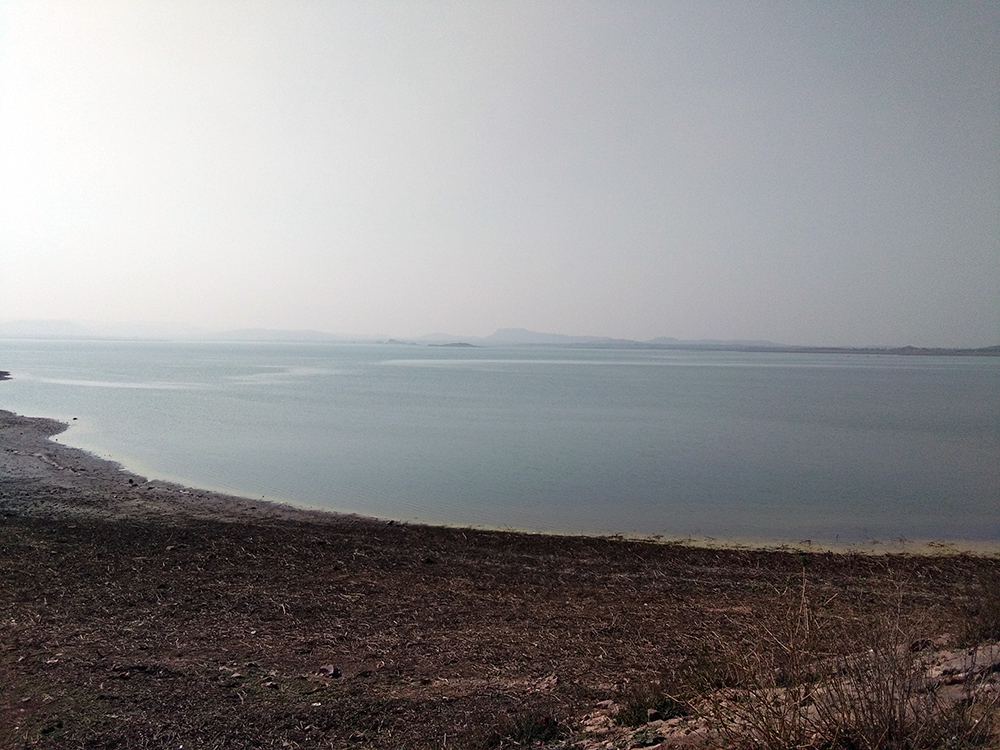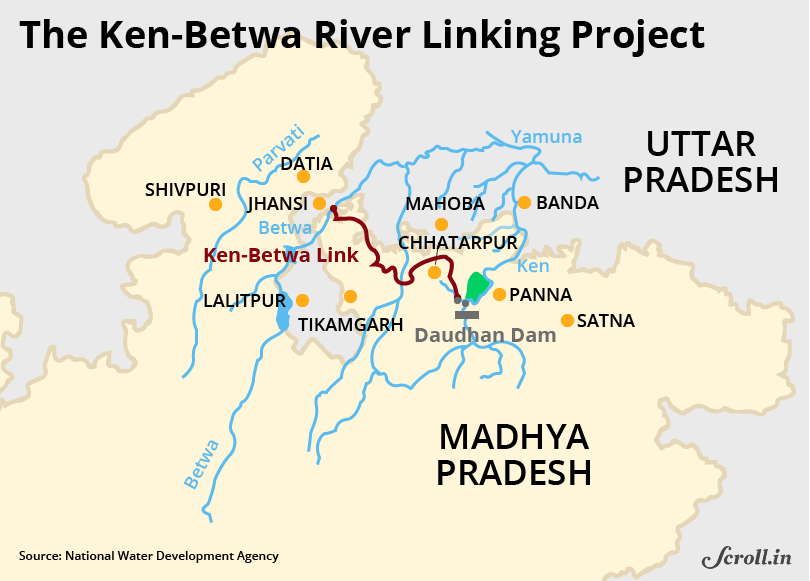The government is going ahead with the project, which it says will transfer surplus water from the Ken to the Betwa and help prevent drought in Bundelkhand.
Spades and shovels will soon hit the banks of the Ken river in Panna district of Madhya Pradesh. On February 11, a committee of officials from the Union Ministry of Water Resources and the NITI Aayog approved an investment of Rs 18,000 crores for a project that will channelise water from the Ken to the Betwa river, about 250 km away.
The Ken-Betwa project is the first in the Union government’s gargantuan Interlinking of Rivers project, which aims to link 30 rivers across India at a cost of about Rs 6 lakh crores.
The government argues that transferring water from what it calls “surplus” rivers to so-called “deficit” rivers will lead to a better utilisation of water for drinking and irrigation purposes, and reduce the possibilities of flood and drought.
At Daudhan in Panna district, a dam will be built to divert water from the Ken to Betwa through canals.
The detailed project report for the proposed link claims that this will facilitate irrigation for 6.35 lakh hectares in six of the 13 districts that form the Bundelkhand region – Chhatarpur, Tikamgarh and Panna districts in Madhya Pradesh, and Mahoba, Jhansi and Banda districts in Uttar Pradesh. The report also says that the project will bring domestic drinking water for 13.42 lakh people in the region and 78 megawatts of power from two hydropower stations.
The government’s rationale
The project is based on the theory that there are surplus rivers and deficit rivers.
But is the Betwa a deficit river?
It is true that by the time the Betwa reaches Bundelkhand, it is running low on water. Seven large and small dams built upstream hold water for Bhopal and Vidisha, leaving barely any water for places downstream.
There are more industries along the Betwa than the Ken. Even the irrigation needs are more pressing along the Betwa since large parts of upstream Ken are covered with forests, including the Panna Tiger Reserve.
Once the link is formed, the water diverted from the Ken is expected to reach downstream districts of Jhansi, Mahoba and the western reaches of Banda.
Opaque data, questionable claim
But ecologists question the assumption that Ken is a surplus river as compared to the Betwa. How does the government define the word “surplus”, they ask.
Currently, the government seems to be taking into account unutilised water from a particular river. This is derived after taking into account all the water-use potential of that basin – drinking water needs, appropriate irrigation, sewage utility and ecological needs of the river to rejuvenate itself. District-level officials collate this data and hand it over for tabulation at the state level.
The figures that show the Ken as surplus and Betwa deficient are not in the public domain.
The National Water Development Agency, which prepared the project reports for the Ken-Betwa link, refused to divulge the figures as both the rivers are tributaries of the Yamuna in the Ganga Basin. The Ganga flows through Tibet, Nepal, India and Bangladesh. Water sharing between these countries has been controversial and hence the hydrology of rivers in the Ganga basin remain a secret.
Asked whether experts have vetted the hydrology of the Ken and Betwa rivers, RK Jain, Chief Engineer at the National Water Development Agency, said that the Central Water Commission had taken a close look at these rivers and was satisfied with the figures.
Himanshu Thakkar, an environmentalist who studies dams and rivers in India, said the secrecy is disconcerting. “Unless we know that Ken is surplus and Betwa is deficit, how do we agree that this massive project is required?” he asked. “Two-thirds of irrigation in the country happens through ground water and the Ken basin is no different. This crucial figure is not taken into account by the government at all.”
River water is critical for ground water recharge. If the course of a river is changed, there will be no ground water recharge in specific areas. In this case, water from the Ken will be diverted to the Betwa from Panna district. Flowing through Chhatarpur district, it will connect with the Betwa in Tikamgarh district. Downstream areas of the Ken, such as agriculture-rich eastern parts of Banda district, will face a severe shortage of ground water as there would not be enough of a river flow to recharge it.
Floods to droughts
The government has also claimed that the river linking project will help tackle floods along the Ken by periodically taking water away from it.
Ecologists question this assumption. They say taking away water from Ken will imperil drinking water needs in downstream areas, especially during the summer.
In January, even the upstream reaches of the Ken were dry, with narrow streams of water flowing without continuity. Four small rivers – Sunaar, Biyarma, Midhasan and Galko – join the Ken at Powai in Panna district. The river, which should swell at Powai, was struggling to keep its head above the ground.
“Flooding in Ken is seasonal,” said Munna Maharaj, a farmer in Rengua village, who owns 15 acres of land on the banks of the river. Ken floods because of rocky structures that act as a natural dam. “All we need is for the government to increase the width of the river where the rocks form a natural dam,” he said. If the rocks are widened at the spot it would reduce seasonal floods significantly, he added.
Such a project would cost the government not more than Rs 20 crores, estimated Lallan Singh, who has a contract to construct a lake in Panna.
Said Maharaj: “Why spend Rs 18,000 crores when we can all benefit from not more than Rs 20 crore?”
Officials at the National Water Development Agency, however, believe that the cost of the Ken-Betwa link far outdoes the benefits, referring to the power-generation capabilities of the project, and the drinking water facilities to downstream areas.
But activists point out that both the Ken and Betwa are forest rivers that are born in the forests of central India. When Ken has a dry spell, so does Betwa. “Why are they proposing to link two rivers whose flow, rejuvenation and origins are similar?” asked Prem Singh, a farmer in Banda district.
Ecological balance
The impact of the project on the tiger reserve and the ghariyal sanctuary in Panna was also a matter of serious concern. “If you export water from Ken to Betwa, the tiger reserve will suffer substantially,” said Irene Cynthia, the district collector of Panna. “There were no tigers in 2008 and officials struggled to bring the numbers up. Today, we have 36 tigers in the reserve.”
The ghariyal sanctuary has just one reptile, according to the guards at the sanctuary entrance. “We need to save it desperately,” said Cynthia.
That is not all. Ken originates in the forests of central India. The proposed dam will be constructed at Daudhan, in the middle of the Panna Tiger Reserve, entailing the felling of more than 10 lakh trees. “How will the river rejuvenate itself without the forest?” asked a local worker of the Bharatiya Janata Party in Panna, who requested anonymity since he was speaking against his party’s stated position.
Fast and easy clearances
Activists are surprised at the speed with which the clearances came through for the Ken-Betwa river link.
In early January, the project was cleared by the National Green Tribunal and Union Ministry of Tribal Affairs. It received environmental clearance from the Ministry of Environment and Forests around the same time. “Did the report mention that cutting 10 lakh trees at the heart of the country will change the ecology irreversibly?” asked Prem Singh, a farmer-activist. “Procuring an EC [environmental clearance] has become a joke.”
In August, to the surprise of many, the National Board for Wildlife also cleared the project.
“That was the most shocking,” said Gunjan Mishra, an environmentalist based in Chitrakoot, Uttar Pradesh. “How did the NBWL [National Board for Wildlife] agree to let go of 40 square kilometres of the Panna reserve? It is not the question of tigers alone. It is the entire ecosystem that gets affected because of that.”
In October, the Union Cabinet approved the River Ganga (Rejuvenation, Protection and Management) Authorities Order, 2016, which calls for the establishment of a national agency called the National Mission for Clean Ganga. Any construction or deforestation in the Ganga basin – of which Ken and Betwa are a part – will require clearances from this agency.
“How did Uma Bharti [the minister for water resources] announce that the Ken-Betwa link will kickstart without this crucial clearance?” asked Mishra.

Rangawa dam over the river Ken in Madhya Pradesh. Only if this dam is full, do the plains of Uttar Pradesh get any water. (Photo: Raksha Kumar).
The only roadblock for the project could be the funding pattern. The project falls under the Accelerated Irrigation Benefit Programme, which mandates that the Centre contributes 60% of the funds required for a project, and the state takes care of the remaining 40%. The Ministry of Water Resources, which is keen on the Ken-Betwa project, has asked the NITI Aayog to change the funding pattern to 90:10 – or 90% funding by the Centre. The NITI Aayog is yet to agree. However, Minister of State for Water Resources, Vijay Goel, announced that all clearances and approvals for the project have been obtained and work will begin soon.
Meanwhile, in Panna, a quaint town with run-down buildings, most long-term residents believe that the Ken-Betwa link will transfer water from the Betwa to the Ken and not the other way round. “Ken is the smaller river, with a smaller dhaar,” said Jayshree Sharma, 67, referring to the flow of the river. “Betwa is the larger river. So water should come from Betwa to Ken.”
The popular understanding in the region shows that the government has done little to even inform Bundelkhand’s people of what lies in store for them.
This is the first in a two-part series on the possible impact of the Ken-Betwa river linking project. The second part can be read here.
Published in: Scroll.in
Published on: 26 March, 2017
Link: https://scroll.in/article/829772/where-is-the-data-to-support-the-governments-rationale-for-linking-the-ken-and-betwa-rivers






